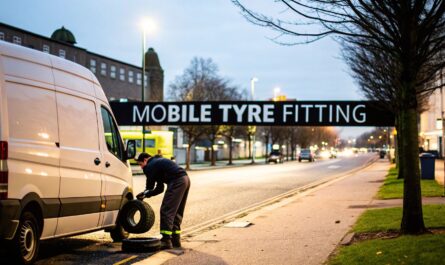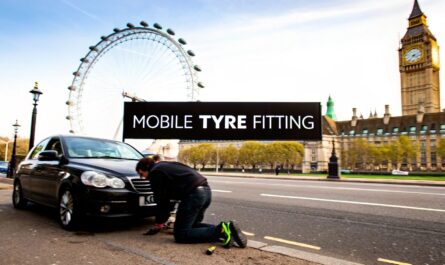If you’ve ever stared at a worn tread and thought “I’ll sort it next week,” this guide is for you. The secret to stress-free motoring is timing—booking mobile tyre fitting at the right moment saves money, avoids delays, and keeps you safe. In the next few minutes, you’ll learn season-by-season timing, ideal replacement intervals, how demand spikes affect slots, and how Crisfix coordinates availability across regions so you’re never stranded.
When to Book Mobile Tyre Fitting: The Smart Timing Guide for Every Season and Region
Expect practical timelines, real examples, data-backed advice, and common mistakes to avoid.
Seasonal timing: when to book mobile tyre fitting
Seasonal weather patterns and travel peaks drive demand. Plan ahead using these windows to secure your preferred slot and price.
Winter and the 7°C rule
– When average daily temperatures sit at or below 7°C, winter compounds offer better grip and shorter stopping distances. See the guidance on winter tyres in the RAC’s overview of the 7°C threshold RAC winter tyre advice.
– In the UK, that often means late October to mid-November for many regions, earlier in the north and highlands.
– Booking window: 2–3 weeks before the first forecasted cold spell to beat the rush.
– Swap-back timing: Plan your return to summer tyres when temperatures consistently rise in spring.
> Book before the first full week of sub‑7°C averages, not after the first frost. That one week’s head start can halve your lead time.
Spring changeovers (winter to summer)
– Many drivers revert to summer tyres around March–April once nights are milder.
– Booking window: 1–2 weeks after clocks change can be busy. Aim for the two weeks before or after that weekend for better slot choice.
– If you run all-season tyres, use spring as a maintenance checkpoint for rotation and tread-depth checks.
Summer holiday surge
– Late June through August brings holiday travel, caravans, and heavy loads. Heat accelerates wear and increases puncture risk.
– Booking window: 10–14 days before long trips. Pair your booking with a pre-trip safety check: pressures, `TPMS` alerts, and spare readiness.
– Consider higher load/XL-rated tyres if you tow or carry heavy cargo in summer.
Autumn rains and leaf fall
– Wet roads magnify the impact of low tread. Hydroplaning risk rises sharply below 3 mm of tread depth, even though the legal limit is 1.6 mm in the UK (see the government’s guidance on legal tyre limits and TyreSafe’s overview of tread depth safety).
– Booking window: Book 1–2 weeks before the first big autumn storm system, especially in regions with frequent downpours.
Lead times, demand spikes, and regional differences
Timing isn’t only about seasons. Regional weather, road conditions, and local events move the needle on availability.
Urban vs. rural demand patterns
– Urban areas: Higher volume and more same-day requests, but more vans and stock nearby. Peak pressure during commuting hours and just before weekends.
– Rural and coastal regions: Fewer vans may mean longer travel times. Weather and tourism can trigger sudden spikes.
– Practical tip: In cities, choose late-morning or mid-afternoon slots to avoid rush-hour traffic delays. In rural areas, plan 48–72 hours ahead unless it’s an emergency.
Weather-triggered spikes you can predict
– Cold snaps, heatwaves, and named storms can triple local demand within hours.
– Use local forecasts to anticipate. The Met Office seasonal pages help you plan around changeovers and extremes: Met Office seasons overview.
– Actionable move: Set a calendar alert for the next forecast milestone (first frost, first 25°C week) and secure your slot before others react.
How Crisfix coordinates timing and availability
Crisfix manages demand across regions by aligning three levers—people, vans, and stock—in real time:
– Predictive scheduling: Live weather feeds and historical booking patterns steer van placement 24–48 hours ahead of spikes.
– Smart inventory: Tyre sizes and speed/load indices are staged in regional hubs based on local vehicle mix and upcoming demand.
– Dynamic routing: Algorithms sequence jobs to minimize travel and maximise first-visit completion rates, with live ETAs and proactive updates.
Case study:
– Scenario: A forecasted cold snap in Greater Manchester collides with a coastal storm watch in Cornwall.
– Response: Crisfix pre-positions winter tyre stock in Manchester overnight, shifts two vans north, and flags flexible customers in Cornwall to bring appointments forward by a day.
– Result: Same-day capacity is protected for emergencies while routine swaps keep their promised windows.
This is how high-availability services keep `TPMS` warning lights, punctures, and changeovers flowing—even when everyone wants the same morning slot.
Lead-time expectations and flexible windows
– Standard lead time outside peaks: 24–72 hours.
– During regional weather events or holiday weeks: 3–7 days unless you accept flexible windows.
– Tactic: If possible, opt into a “flex window” (e.g., 10 a.m.–2 p.m.). It gives routing systems room to fit you in sooner and often at a lower price.
Maintenance intervals and real-world wear
Knowing when your tyres actually need replacing is half the battle.
Tread depth and legal thresholds
– UK legal minimum: 1.6 mm across the central three-quarters of the tread, around the full circumference (see UK government tyre rules).
– Best practice: Replace at 3 mm for wet grip safety. Braking distances in the wet can increase significantly below this point (see TyreSafe tread depth guidance).
– Quick checks: Use a tread gauge or the built-in wear bars. Don’t forget inner edges on misaligned vehicles.
Mileage, usage, and rotation
– Typical lifespan: 20,000–30,000 miles for fronts on FWD cars; rears often last longer. Performance tyres or aggressive driving shorten that.
– Rotate every 6,000–8,000 miles unless your manufacturer advises otherwise; align if you see uneven wear.
– If you notice cupping, feathering, or persistent pull, schedule an alignment check before fitting new tyres.
Pressure, temperature, and fuel economy
– Underinflation increases heat build-up and wear, and can raise fuel use by several percent; see maintenance guidance in the U.S. Department of Energy’s fuel economy maintenance tips.
– Check pressures monthly and before heavy-load trips. Trust your `TPMS`, but confirm with a reliable gauge.
Emergencies vs. planned replacements
– Emergency puncture or sidewall damage: Book immediately; avoid driving on a flat to protect the casing and wheel.
– Planned replacement: If you’re near 3 mm before a seasonal shift or big trip, book proactively. A deliberate plan beats a forced, last-minute change.
Strategies to save money and avoid delays
Small choices compound into convenience and cost savings.
Booking tactics that work
– Plan around forecasts: Reserve 1–3 weeks before seasonal tipping points.
– Choose flexible windows: Wider time bands often cost less and get earlier slots.
– Pair services: Combine tyre fitting with rotation, valve replacement, or seasonal swaps to reduce repeat callouts.
Common mistakes to avoid
– Waiting for the first frost or storm: That’s when everyone else calls.
– Ordering niche sizes last-minute: Uncommon sizes may need 24–72 hours to source.
– Ignoring wheel locks: Know where your locking wheel nut key is to avoid delays.
Best practices for smooth appointments
– Share constraints: Let the provider know about parking height limits, gated access, or restricted kerb space.
– Confirm specs: Size, speed and load rating, and run-flat status. Use your owner’s manual or driver-door jamb label.
– Keep comms open: Enable notifications so you don’t miss time-sensitive updates or earlier slots.
How Crisfix keeps you moving
– Live re-optimisation: If traffic or weather shifts, Crisfix resequences routes and offers alternate times the same day.
– Stock visibility: Advisors can see regional inventory across hubs, so they can suggest viable brands and sizes without guesswork.
– Regional fairness: High-demand postcodes get extra vans during peaks, preserving emergency capacity while meeting booked commitments.
This is where a well-run network shines: fewer no-shows, realistic ETAs, and higher first-time fix rates—all translating into a smoother experience for you.
Practical examples and timelines
Example 1: Winter change in Leeds
– Forecast: Sub‑7°C days arriving mid-November.
– Action: Book in late October. Choose a 10 a.m.–2 p.m. flex window.
– Outcome: Next-day slot secured, standard pricing, no rush charges.
Example 2: Summer road trip from Bristol
– Plan: Family holiday in late July.
– Action: Tread at 3 mm; book two weeks before departure. Add rotation and valve checks.
– Outcome: Fresh tyres, improved wet grip, and better fuel economy on motorways.
Example 3: Rural puncture in Perthshire
– Issue: Slow leak found Sunday afternoon.
– Action: Use an emergency slot; accept the first available location-safe window.
– Outcome: On-site repair completed, wheel integrity preserved by avoiding low-pressure driving.
Conclusion
Timing transforms tyre care from a headache into a quick, predictable task. By planning seasonally, watching forecasts, and understanding regional demand, you cut wait times, protect your budget, and boost safety. Crisfix adds resilience with predictive scheduling, smart stock staging, and adaptive routing—so peaks and storms don’t derail your plans. The best part? A few calendar reminders and flexible windows are all it takes.
Ready to map out your next changeover week? Set your seasonal reminders today, check your tread, and book mobile tyre fitting before the rush. What’s the one timing tweak you’ll make to stay ahead this year?
FAQ
Q: How far in advance should I book in winter?
A: Aim for 2–3 weeks before the first sustained sub‑7°C week to secure your preferred slot.
Q: What tread depth should trigger replacement?
A: Replace at 3 mm for wet safety, even though the legal minimum is 1.6 mm.
Q: Can I get a same-day emergency slot?
A: Often yes, especially in urban areas, but availability tightens during storms or cold snaps.
Q: Do I need to be present during fitting?
A: Typically yes for key handover and locking wheel nut access; confirm specifics when booking.
Q: Are flexible time windows cheaper?
A: They can be. Flex windows help routing and may unlock earlier or lower-cost appointments.





